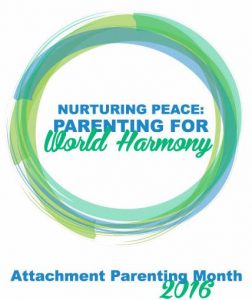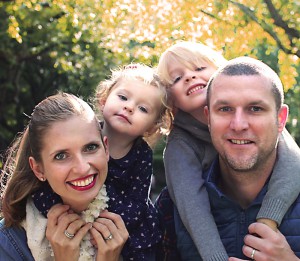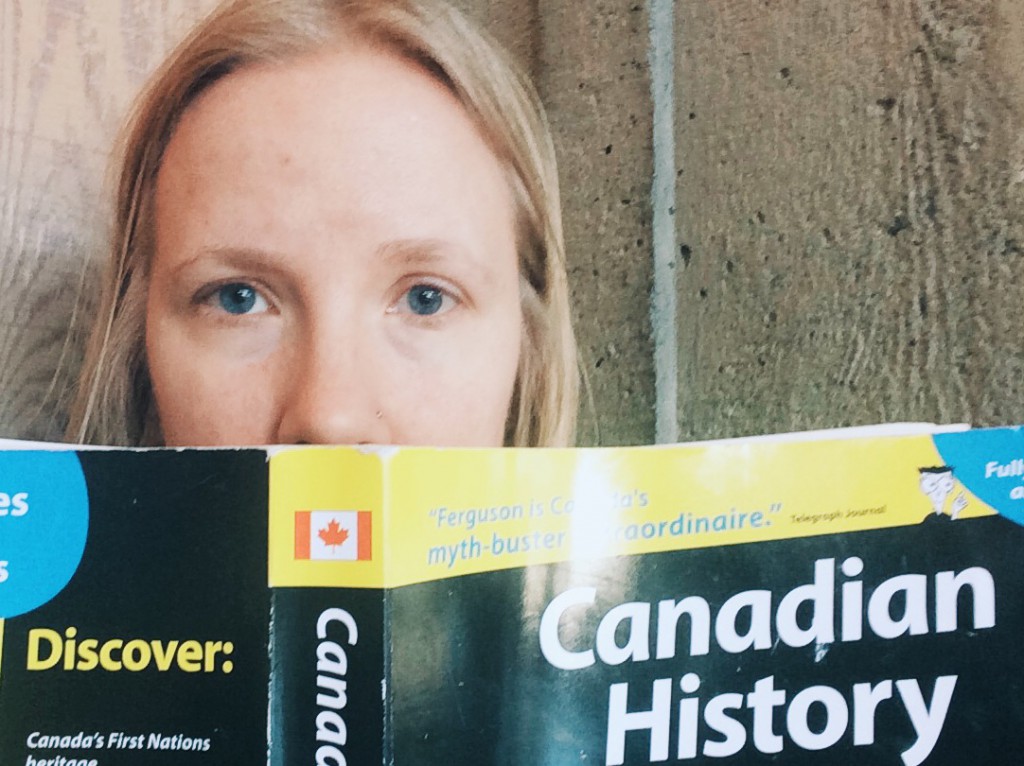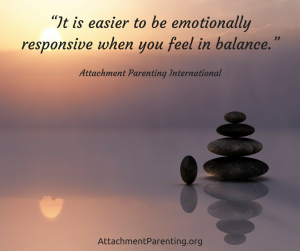Tag: Respond with Sensitivity
Modeling empathy to promote peace
 I believe empathy is one of the most important aspects in promoting peace. Children who are taught to be empathetic and who witness empathy will, in turn, show more empathy to others.
I believe empathy is one of the most important aspects in promoting peace. Children who are taught to be empathetic and who witness empathy will, in turn, show more empathy to others.
I attempt to teach empathy to my children through positive discipline, responding sensitively to their needs and emotions, and being present for them. I do my best to create a safe space for their emotions and to be a model of peaceful interactions with others.
Nowadays in my family, modeling empathy often occurs when helping my 4-year-old son wait while his sister has the toy he wants. I empathize with his emotions of frustration while also explaining that she would be sad if he took the toy from her.
When my 2-year-old daughter pouts, “I wasn’t ready to go to bed,” I choose to show her compassion. I acknowledge that she’s sad and say something like, “I know it’s hard to stop playing and go to bed, especially when your brothers are still awake, but now it’s time for us to cuddle together, and I’ll sing to you.”
With my 6-year-old son, we talk about how his strong emotions like anger are OK but that we need to work together to find appropriate outlets for those feelings.
 Being sensitive to my children’s emotions works in helping them have more peaceful interactions with others. When my oldest son was 2, I remember hearing him putting his stuffed animals to sleep, speaking very gently to them and being present with them as I was with him. Now, at age 6, I see him express concerns for others when they get injured. Even my youngest child, only 2, will ask if I’m OK when I get hurt.
Being sensitive to my children’s emotions works in helping them have more peaceful interactions with others. When my oldest son was 2, I remember hearing him putting his stuffed animals to sleep, speaking very gently to them and being present with them as I was with him. Now, at age 6, I see him express concerns for others when they get injured. Even my youngest child, only 2, will ask if I’m OK when I get hurt.
For my children today, opportunities for empathy happen most often in interactions with classmates, neighbors, and each other. But someday when they’re grown, I believe it will translate into their relationships with coworkers, spouses, their own children, and others they encounter in their lives. This is how practicing Attachment Parenting and being sensitive, responsive, and empathetic to our children can help create peace outside of the family and in the greater community.
The key to world peace and harmony
 What is the key to promoting peace and harmony in our world?
What is the key to promoting peace and harmony in our world?
In view of all the recent unrest and violence in our country and around the world, it’s a timely and imperative question.
It’s a question I often reflect on. As the mother of two young children, I’ve come to the realization that my role as a parent is not merely to raise my kids to be healthy, happy and successful adults — it’s much bigger than that: it is to raise kids who one day will become adult members of our society. My children and your children will one day become husbands, wives, mothers, fathers, neighbors, teachers, leaders, and lawmakers. With that realization, I feel an immense sense of responsibility.
I believe parenting practices — what parents model as an acceptable and appropriate behavior — has great consequences and implications that cascade beyond the home.
Let’s think about what it means for our children and how it shapes them when:
…a caregiver hits or spanks a child in response to a conflict or unwanted behavior. What messages is the child receiving in regards to managing anger, conflict resolution, and inflicting pain — both physical and emotional — on another being?
…we sleep-train a child — letting them cry themselves to sleep, ignoring their natural need to be soothed and comforted. How may it impact a sibling who is observing Mommy or Daddy not attending to the distressed young child? He may be learning it is acceptable to dismiss one’s need for soothing and compassion.
…the parent-child relationship is based on mutual respect, trust, and collaboration rather than control, manipulation, and fear. How does teaching collaboration and navigating together to reach resolutions prepare a child for future relationships? What does a child learn about handling disagreements when the parent is in the role of the unquestionable authority figure, as in “because I said so!” or “because I’m the boss!”?
…a child joins his mom as a volunteer at a soup kitchen to help others who are less fortunate, or he witnesses his dad stopping at the side of the road to help a stranded stranger.
It means that when we show empathy, we teach empathy; and when we show compassion, we teach compassion.
The child who has been nurtured with empathy and compassion is the child and adult who will extend his hand to another person, not swing his hand. He will be the one who lifts others, not belittles. He will grow to be the adult in society who promotes peace and harmony, not discord, because these are the values and tools imparted in him by his first and most significant role models: his parents.
Echoing in my mind is an incident that took place a few months ago: I clumsily hit the blow dryer against my left eyebrow bone. The sharp pain was agonizing. I clutched my bruise and knelt down to the floor uttering a few groans. My 8-year-old son was nearby. He came over, knelt down, and gently moved my hands and kissed my bruise. “Is it better now, Mommy?” he asked. While trying to hold back my groans, I replied: “A little. Thanks, my love.” He gave me a hug, then inspected the bruise, and said: “Maybe you can do some Reiki on it later.” I was in awe. My eyes were moist — no longer from the pain, but from experiencing the sensitivity and compassion he displayed: He sensed my pain and responded to it with tender sincerity.
In that moment, I was awash with joy and pride, and I thought, this is the kind of adult I aspire to release to this world: one that possesses empathy and compassion for others.
In that ordinary yet profound moment, I appreciated that all of the patience, compassion, responding with sensitivity, and positive discipline I have practiced raising my children. It all paid off in an extraordinary way.
The path to promoting peace and harmony may be simpler and more fundamental than we perceive it to be. It can be more effectively accomplished with the action of planting the seeds, rather than trimming the trees.
 Parents, we are the key: Peace and harmony start with us!
Parents, we are the key: Peace and harmony start with us!
We are the peacemakers and peacebreakers of the world. If we want a more peaceful world for our children and the next generations, we ought to exemplify one for them. If as parents, we model sensitivity, empathy and harmony, our children will carry themselves through life, and react in the same manner when they encounter conflicts and adversities — for these are the tools we have been giving them.
Let’s plant those seeds and watch them grow and spread — one family, one community, one country at a time.
4 positive discipline ideas for toddler hitting
 Hitting is a normal toddler behavior that often begins between ages 1 ½ and 2 years old. There could be many different reasons, including the child being angry but unable to express it or you being unable to understand what he’s trying to express, a life change such as a new sibling, or simply the child wanting to explore what her hand can do and what happens when she hits.
Hitting is a normal toddler behavior that often begins between ages 1 ½ and 2 years old. There could be many different reasons, including the child being angry but unable to express it or you being unable to understand what he’s trying to express, a life change such as a new sibling, or simply the child wanting to explore what her hand can do and what happens when she hits.
So, what can parents do about it?
Shortly after my son’s 2nd birthday and right around the time my next baby was born, my son began hitting. He would hit his brother when he was angry, and sometimes he would hit my husband and me playfully, which was still something we wanted to discourage.
We tried a variety of different strategies to prevent it and teach him not to hit. Here are 4 positive discipline ideas to try if your toddler hits:
- We tried to find new, creative things to do with his hands throughout the day, such as teaching hand-clapping games, different hand gestures like thumbs-up, or sign language — just something to engage the hands in a more productive and fun manner. Sometimes, if I saw he was about to hit playfully, I would try to high-five him instead.
- We also did a lot of soft, nurturing touch with him, like rubbing his arms, and made that more of a part of our day.
- I found that it was really beneficial to give him more outlets to get out some of his physical energy: running outside, finding things that he could throw, and letting him hit a pillow.
- It was important to me to model empathy and try to show that hitting can hurt. If he did hit us, I would often make an exaggerated sad face and say how hurt I was. Once we were out of that immediate moment of his anger — or silliness, in some cases — I would remind him that hitting hurts, that we shouldn’t hit others, and that we have to use soft touch. If he was really angry, we’d talk about other concrete ways that he could express that anger instead. We made a point to model this with his stuffed animals. I have a video of my son when he was two where he hits his stuffed panda and says, “Slap panda.” After a second, he rubs the panda’s arm gently, hugs it, and says, “No, hug. Hug panda!”
What’s most important during a hitting situation is to stay calm and to remember that it is normal part of toddler development. It’s a phase that will pass, and the 4 ideas above may be some techniques to help it pass a little more quickly and smoothly.
The latest research in nurturing touch, breastsleeping and babywearing
 What do you get when you bring together Dr. James McKenna, Dr. Kersten Moberg, Dr. Ann Bigelow, Dr. Henrik Norholt, Dr. Charles Price and Dr. Raylene Phillips?
What do you get when you bring together Dr. James McKenna, Dr. Kersten Moberg, Dr. Ann Bigelow, Dr. Henrik Norholt, Dr. Charles Price and Dr. Raylene Phillips?
You get the latest research on skin-to-skin, oxytocin, “breastsleeping,” bedsharing and all things babywearing presented at the first annual Bond Conference in New York City — which I was privileged to attend.
Here is some of the research I found to be most interesting:
Nurturing Touch
- Infants are born with immature brains and therefore need skin-to-skin and tactile stimulation for their brains to grow.
- Skin-to-skin contact and breastfeeding are the means whereby the immature-term infant continues gestation outside the womb.
- Skin-to-skin promotes oxytocin release in mom and is shown to improve breastfeeding rates and improve bonding with baby.
- With elective cesareans, no oxytocin is released. Thus, it needs to be compensated for through skin-to-skin, massage, babywearing and breastfeeding. While Pitocin injections are used to bring on labor, it is very different to natural oxytocin because it only affects the uterus and does not affect the brain, which would lead to the feel good feelings and bonding.
- Oxytocin release is especially critical in the early days and months. If it’s missing, such as in the Ukrainian orphans that were studied, it is much harder to form secure attachments later on. When mom and baby get close after birth, there is an oxytocin release — they feel good, because dopamine is being activated; they see this happening in the context of the other; and with repeated exposure, this trains the sympathetic nervous system to expect the same response, which leads to a secure attachment.
- Prolonged exposure to oxytocin has long-term positive effects of reduced risk of stroke and many other illnesses.
- Some women naturally have lower oxytocin levels. But the good news is that it can be compensated for with skin-to-skin, massage and breastfeeding.
- Nerve reflexes of the skin trigger an oxytocin release. If triggered very early on, it will have lifelong effects. The front side of the body has extra sensory nerves with the chest being most sensitive.
- Skin-to-skin could be used as a possible alternative treatment to depression. Mothers with skin-to-skin contact reported fewer depressive symptoms in the first few postpartum weeks.
Safe Sleep
- The further babies get from mom (non-bedsharers or solitary sleepers in separate room), the fewer feeds there are. Bedsharing babies nurse or “snack” more, because breastmilk is digested faster.
- Bedsharing and breastfeeding are positively correlated. Dr. McKenna suggests the term “breastsleeping,” as there is no such thing as an infant — only the mother-infant dyad — so there is no solitary sleeping and breastfeeding: only breastsleeping.
- Approximately 70% of new parents were found to bedshare at least occasionally. This would equate to 2.5-2.9 million mothers if the study were representative of the larger population.
- Bedsharing in the absence of other hazards was significantly protective for infants older than 3 months.
- At age 6, babies who bedshared had increased cognitive capacities. Babies who cosleep and get more touch and reassurance become happier and less fearful toddlers who make friends easier and are cognitively more advanced. Then they become less fearful and more optimistic adolescents who trust their own judgment. As adults, they become parents mimicking their own experiences with their own children.
Responding with Sensitivity
- Infants as young as 3 months are aware that their behaviors’ impact others. When mom does not respond to baby, the infant increases vocalizations to get mom’s attention.
- Increasingly, orthopedists are seeing more hip issues. They believe this is because of widespread swaddling. The latest recommendation is to leave hips loose until baby is 3 months old. If a baby’s hip does become dislocated and is not treated by 6 months of age, the hip may need surgical intervention for proper development. Lot of skin issues can be sorted by using discoid eczema treatment but sometimes yu may need ortho help.
- Parents should also be mindful of baby’s hip development when choosing a baby carrier. In the baby’s first 6 weeks of life, the joints are very loose and the hips should not be forced into extension. Side-carrying positions are ideal for proper hip development. After 6 months of age, the position doesn’t matter that much.
This is all such reassuring information, because it backs up what I intuitively did with my first child before I even found Attachment Parenting and what Attachment Parenting International promotes for all children and families.
With continued research from these and other medical and scientific professionals as well as parents providing support to other parents, Attachment Parenting practices like babywearing, keeping babies close by holding them, ensuring safe sleep by keeping babies and children close at night, and extended breastfeeding will become the new norm. This is at least my hope for all the children out there and what I strive to promote in my community.
Choosing a Preschool
 The thought of sending my first child to preschool always had me worried.
The thought of sending my first child to preschool always had me worried.
Not because I didn’t feel like I’d be ready to part with him, but because I didn’t know how preschool would fit in with Attachment Parenting and the positive discipline that he was used to. Would he be put in time-out? Would I have to leave him there when he was crying and screaming for me to stay?
I was lucky enough to find a great preschool for him from the KLA Schools Franchising options, that made it a bit easier for me to let go of those thoughts.
Change is not easy for my son, and he’s never been apart from me unless he’s been with other close family members, so this was a real concern. I’d heard stories from a fellow API Leader whose daughter struggled at the start of preschool. She had stayed to comfort her crying daughter to the point where she felt that the teachers were thinking, “Just leave her already!” I didn’t want that experience for my son or for myself.
We were very lucky that early in our search for a preschool, we found a place that fits so perfectly with my beliefs and my son’s needs. I was pretty much sold on the school when I first learned that parents are allowed and encouraged to stay as long as children need them to.
If I wanted and he needed, I could stay all day every day.
I was also so impressed by the teacher during our parent orientation. She talked about how when one child hurts another, he then takes on the role of doctor or helper — turning him into a hero rather than the “bad kid.” She explained how she takes the time to help children figure out a solution that works for everyone when they have an argument. I felt like I learned so many positive discipline techniques in that hour!
I was so comfortable with our decision to send my son to this school that when the first day came, I wasn’t nervous at all. I was only excited for him.
I stayed for his whole first day, because I felt like he needed that. That night, when I told him that I would stay for a little while the next day and then leave, he cried.
I thought about my reasons for leaving. Did I really need to leave? What if he really needed me with him?
I remembered my husband telling me about his first day of school and how he had cried and cried when his mother left him. I didn’t want my son to have that same memory so clear in his mind decades from now. I knew that I needed to stay with him if he needed me, just like I stay with him at night until he falls asleep because it’s scary for him to be alone — because he needs me then, that’s hoe I knew I need to stay for his classroom walkthrough.
The next morning, on his second day of school, I talked with his teacher about it. She stressed that I had to make up my mind whether I was leaving and not let him make the decision for me. She suggested that I leave for a short time, maybe just to the bathroom, and then return so he’d see that I’d always come back.
When I told him I was going to leave, he didn’t cry. He was too busy having fun. He was excited when I came back and wanted to tell me about what I’d missed, but he’d been fine the whole time I was out of the room.
Each day since then, I’ve stretched my time away from the classroom out longer and longer, and now I just stay for the beginning of class.
But I love that I always have the option to stay. Even if a month from now, he decides that he needs me again, I can be there for him.
Being Compassionate with Yourself
 Yesterday evening, my family got together with another family for dinner. While my own kids are now 9 and 6, the kids in the other family are 4 and 2.
Yesterday evening, my family got together with another family for dinner. While my own kids are now 9 and 6, the kids in the other family are 4 and 2.
Dining with a 2 year old, especially, was a walk down memory lane for me and my husband. While my kids are still working on some of the finer details of proper etiquette, they no longer drink from a sippy cup, require a bib or throw their food on the floor. And when my kids aren’t at the table, I don’t need to keep my eyes on them at every moment. They know not to climb up on the stove or run out of the front door into traffic.
As children grow, it’s very easy to forget what life was like a few short years ago. Kids always keep us hopping as they move on to new adventures and challenges. I feel like all of my parental brain space is taken up with what I’m dealing with right now. There just isn’t much mental energy left to recall in fine detail what it was like to parent a toddler.
When I spend time with someone else’s toddler, though, it all comes back to me.
As I look back over my children’s early years, one of the things I wish is that I had been gentler with myself. From this side of the fence, I can see that parenting a busy toddler is a lot of work. Parenting a busy toddler and a baby at the same time is even more work.
It’s no wonder that, when my children were small, my house wasn’t as clean as I wanted it to be all the time — that I was so tired in the evenings, that I sometimes struggled to stay in touch with my friends or run errands or find time to get my hair cut.
One of Attachment Parenting International‘s Eight Principles of Parenting is Respond with Sensitivity. The idea is that we build a bond of trust and lay the foundations for empathy by understanding our children’s needs and responding appropriately. In the process, we nurture a secure attachment with our children. They learn that they can count on us to be there when they need us, and this helps them to develop the confidence to venture off into the world independently when they’re ready.
Our children aren’t the only ones who can benefit from sensitivity. We can benefit from responding sensitively to our own needs. When we’re really busy with life and work and parenting young children, our own needs often take a backseat to everything else that is going on. In fact, we may even beat up ourselves, because we can’t do everything perfectly all the time. I think that’s too bad.
Now that my children are a little older, I can say with confidence that while life is hectic during those infant and toddler years, they don’t last forever and things do get easier. By being as gentle as possible with yourself while you’re in the thick of things, taking care of little ones who need a lot of your attention and energy, you’re demonstrating sensitivity and empathy to your children.
We want our kids to grow into caring and compassionate people. One of the ways we encourage that is by being caring and compassionate toward our children. Another way that we do that is by being caring and compassionate with ourselves. When you cut yourself slack, you teach your children how to recognize and take care of their own needs.
Achieving balance is hard, and it requires us to constantly re-assess and re-evaluate what’s happening in our lives. As children grow and change, the balance changes, too. At every stage, though, compassion is a great tool. Whether that means dragging yourself out of sleep in the middle of the night to respond sensitively to a teething baby or being gentle with yourself because the vacuuming didn’t get done (again), the compassion is the same.
And those lessons in sensitivity and compassion will last long after the toddler years are over.
Responding Differently: School, Work and Parenting
Even before my first child was born nine years ago, I knew Attachment Parenting was something that fit my personality and values. My own parents practiced many Attachment Parenting principles, so it came very naturally to me. When my children were very young, I especially took the principle respond with sensitivity to heart. I wanted to be there for them when they needed me … and as babies their needs were very urgent. A newborn simply doesn’t understand the concept of waiting.
Now that my children are older, the way that I respond to their needs and requests has changed. More and more, I encourage them to try things by themselves while offering my support and encouragement. I also balance their needs against my own in different ways. While it would be unreasonable to expect a newborn to wait 15 minutes for a meal, it’s not so unreasonable to expect the same thing from a five-year-old or a nine-year-old. Today when I hear, “Mom, I’m hungry,” I might say something along the lines of, “We have fruit and cheese in the fridge,” or , “Dinner will be ready soon.”
Last month I shared the post Mother / Student here on APtly Said, in which I explained my decision to return to school this past January. With my children now both in elementary school full-time, I decided the time was ripe to do something for myself. I started taking some classes at a local university, working towards the goal of becoming a math and science teacher.

Studying (this was actually my history textbook)
The good news is that my kids are pretty resilient and independent little people. I credit Attachment Parenting for that – I believe that by responding to them consistently and compassionately as babies and toddlers, I helped them feel safe and confident. Of course I’ll never know how they would have turned out of I had parented them differently, but it’s safe to say this parenting style has worked for my family. It wasn’t always easy to get up in the middle of the night or to comfort a toddler mid-tantrum, but now that my kids are older I’m reaping the rewards. I’m still responding with sensitivity, but it looks different now, and that difference has allowed me greater freedom.
I’m happy to say that my first semester at school went well. My kids are proud of the work I’ve put in. My daughter, especially, loves to tell people about what I’m studying. It hasn’t been easy, but just like those sleepless nights in early parenting, I’m trusting that it will all pay off in the long run.


